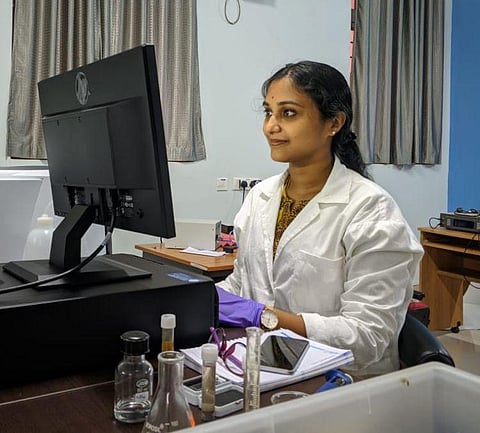

KASARAGOD: A team of PhD researchers at the Central University of Kerala (CUK) has developed a self-testing kit to detect sodium concentration in urine and blood serum, which could revolutionise clinical diagnosis.
The nanotechnology-based sodium sensor is a part of the PhD work of Dr Neeli Chandran (30) and was published in Nature's 'Scientific Reports'.
"Today, we have to go to a (clinical) lab and do an electrolyte test to find if there is any sodium imbalance in our body. The test will cost us at least Rs 150. But our paper-based dipstick cost just Rs 20. If produced on a commercial scale, it would be much cheaper," said Dr Chandran, who was guided by Prof Swapna Nair of the Department of Physics.
The sodium sensors are a collaborative work of the Department of Physics and the Department of Biochemistry and Molecular Biology of the university. Diabetes and kidney patients are prone to sodium imbalance, which can trigger a series of serious problems such as nausea, headaches, fatigue, memory loss, muscle weakness, cramps, seizures, and cardiac issues, said Prof Rajendra Pilankatta, head of the Department of Biochemistry. "Patients can also show behavioural abnormality, faint or even slip into a coma," he said.
So early and easy detection of sodium imbalance can be a life-saver, said Prof Pilankatta, who co-guided Dr Chandran.
Four years of rigorous work
Dr Chandran, and PhD scholars Prajith J and Manikanta B spent four years developing the sodium testing kit in Prof Swapna Nair's lab, which specialises in biosensors, internet of things sensors, magnetic field sensors, optical, UV and infrared sensors.
The sodium sensor was made by placing curcumin, a chemical derived from turmeric, on top of three to nine nanometres-thick copper particles, said Prof Nair. The curcumin coating protects the nano-copper from getting oxidised. "The end synthesized product is an ink-like solution called quantum dots which we use to print the paper strips," she said.
The Quantum dots worth Rs 10,000 can be printed on 500 strips, that is Rs 20 for a strip. The strip reacts with the sodium in urine or blood serum and produces a unique colour depending on the sodium concentration. "We have developed a chart with nine colours for users to compare their strips. Each colour gives a range of sodium concentration in their urine or blood serum," Prof Nair said.
For urine, the reading should be above 20 mili-equvalence per litre (mEq/ l) and for blood serum, it should be between 135 and 145 mEq/ l, said Prof Pilankkata. "A reading below 125 is problematic," he said.
AZoNano, an online platform for the nanotechnology community, reviewed the paper published in 'Scientific Reports' and said: "The development of sodium sensors is of high clinical relevance."
Although sodium concentration detection methods such as ion-selective electrodes and ion chromatography give accurate results, their high cost, complex technicality and high sample requirement limit their regular usage, it said. "To this end, paper-based dipsticks are cost-effective, user-friendly alternatives that can give rapid results," it said.